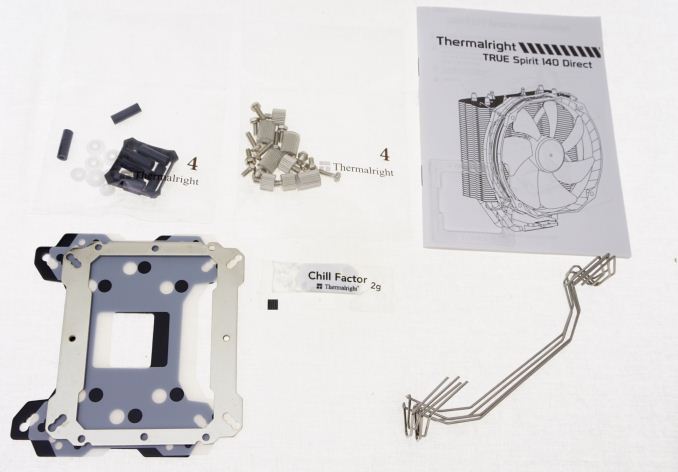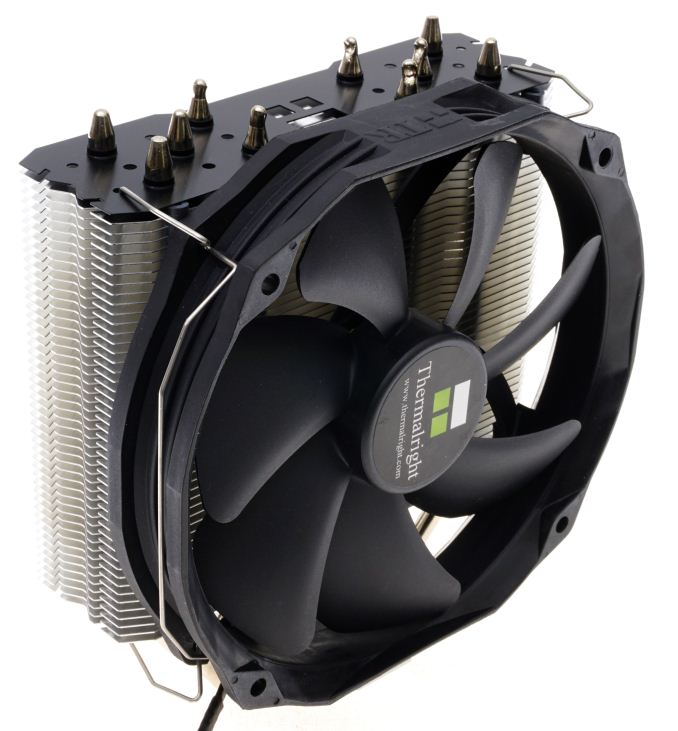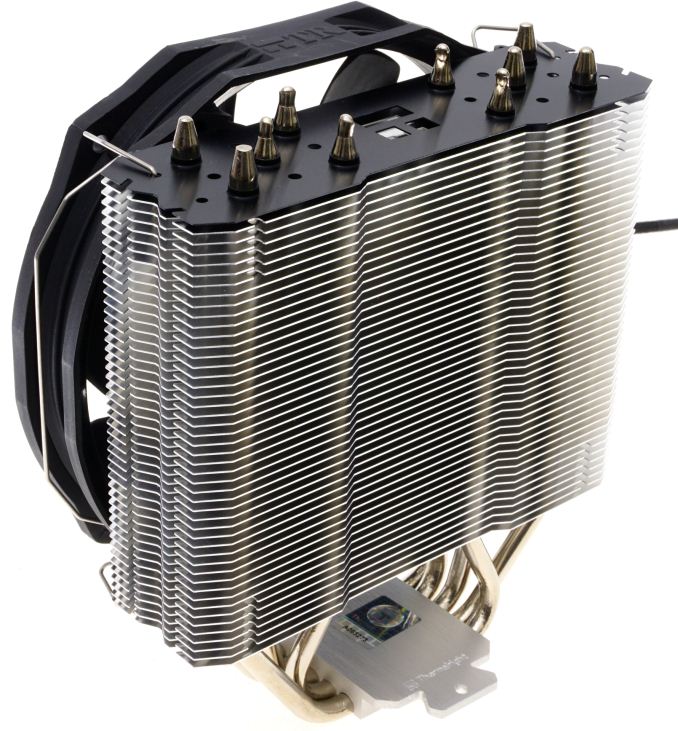The 140mm Slim Tower CPU Cooler Roundup: Thin & Light Done Just Right
by E. Fylladitakis on May 24, 2017 8:00 AM EST- Posted in
- Cases/Cooling/PSUs
- be quiet!
- Noctua
- Phanteks
- Cooler
- Thermalright
Thermalright True Spirit 140 Direct
Thermalright is practically a newcomer here in AnandTech, as we have not looked at any of their products since 2010 and our last Thermalright CPU cooler review is now nearly a decade old. The cooler that we will be reviewing today is the Thermalright True Spirit 140 Direct, the upgraded version of their popular Thermalright True Spirit 140 cooler. It comes supplied inside a dark box with minimal artwork, only a clear picture of the cooler itself and icon denoting its most important features.
Inside the box we only found the absolute necessary parts for the installation of the cooler, which are a one-fits-all backplate, mounting hardware, fan support wires, fan anti-vibration standoffs, and a small but detailed installation manual. Thermalright also supplies one dose of their “Chill Factor” thermal compound.
Much like Noctua’s and Be Quiet!’s offerings, the Thermalright True Spirit 140 Direct has a single 52 mm deep fin array with a 140 mm fan attached on it. The fin array is relatively simple, with only a recessed center area to reduce the aerodynamic drag noise. The top fin of the array has been painted black for aesthetic purposes. It has five 6 mm nickel-plated heatpipes.
Thermalright is using one of their TY-140 cooling fans on the True Spirit 140 Direct. The TY-140 is a PWM general purpose cooling fan that has been initially designed with 120 mm mounting holes to maximize compatibility. The company advertises its “Enhanced Hyper-Flow Bearing (EHFB)” engine as consistent and highly reliable, without any further information regarding its design and/or mechanics.
The fan mounting mechanism is strange, with the fan having to sit on rubber standoffs that need to be inserted into small cutouts on the fin array. It is not possible to mount the fan without these standoffs. Hopefully the rubber that they are made of will last for several years, but replacements may be necessary for people who keep their hardware for more than a few years or if they are lost. (Tip: Pieces of large drinking straws do work as a temporary solution)
The large difference between this cooler than the others in this roundup review (and also its major upgrade over the previous version) is the design of its base. Instead of having a contact plate coming in contact with the CPU and the heatpipes attached to it, the heatpipes of the True Spirit 140 Direct are in direct contact with the CPU itself. The top part of the base is made of machined aluminum and only provides mechanical cohesion and retention bracket support.
















74 Comments
View All Comments
Yuriman - Wednesday, May 24, 2017 - link
Nice review! Please do more of these.One thing I'd like to see is to have the coolers' thermal resistance normalized for noise. I understand that's not an easy task, but it would be nice to see how much each can dissipate at a given noise level (the only two metrics most people really care about), rather than having both noise and resistance being variables.
Paapaa125 - Wednesday, May 24, 2017 - link
I agree, that would be the best data. If not feasible, I'd like to see the thermal characteristics of each cooler using the same fan at the same speed (tested at many levels).Lolimaster - Thursday, May 25, 2017 - link
Ryzen 7 1700 + Hyper 212X <45°C at load @900rpm, can't even hear the thing.fanofanand - Thursday, May 25, 2017 - link
There are way more variables loli, what kind of case do you have? Any added insulation? What's the average sound level in your room? Do you have a high powered GPU that drowns out the CPU cooler? Do you have loud case fans? Do you have a loud PSU? I'm sure you have a very nice system so having a normalized test would clear up the questions for everyone rather than anecdotal "I can't hear it" statements. Not trying to attack what you are saying but I 3rd the idea that normalized testing for performance at a specific sound level would be great. Even then, different sounds can be more grating than others depending on the pitch. This is probably the hardest area of computing to test, is sound.Lolimaster - Saturday, May 27, 2017 - link
Cheapo case, only fans are the cpu, psu (a seasonic) and a RX560 a low rpm + undervolt.The only thing I actually hear are my 3 HDD's, if I boot without those is basically the expected electric hum.
My place is quite silent.
Gigaplex - Monday, May 29, 2017 - link
If you can't hear the Hyper 212X @900rpm you may need to get your ears checked.JocPro - Monday, May 29, 2017 - link
Same here, R7 1700 + Thermaltake NiC L32 (It's a Slim 140mm tower - why wasn't in the review?) 500 RPM idle, ~600 RPM load... I can't hear it, even trying. The case has 4 CM Silencio PWM @ 900 RPM, and only the air pushed is audible.jospoortvliet - Friday, May 26, 2017 - link
I would prefer to see coolers sped up to the point they produce a fixed amount of noise (say 38db or so) and then compare how much they cool. A much better way to compare them.Robotire - Wednesday, May 24, 2017 - link
Interesting topic but I have a hard time getting useful information out of this article. I would have prefered to see noise levels and efficiency at idle and at full CPU load instead of these artificial 7V and 12V levels. Also there is no easy to read conclusion to help people in a hurry choose the best cooler for their need, and I have no idea what the thermal resistance values mean.mgilbert - Wednesday, May 24, 2017 - link
When it comes to air coolers, there's Noctua, then there is everyone else. They are superior in virtually every respect, especially quality and support.